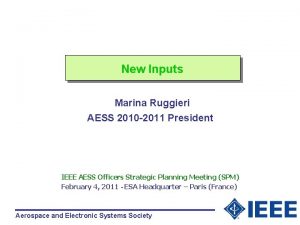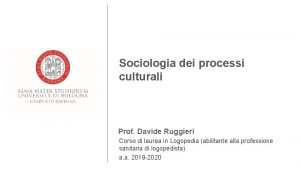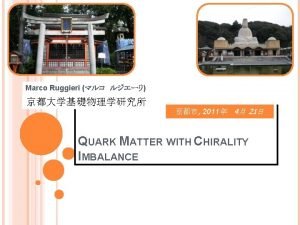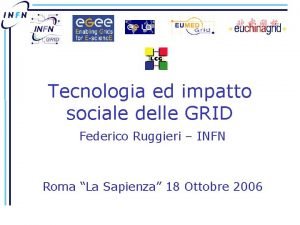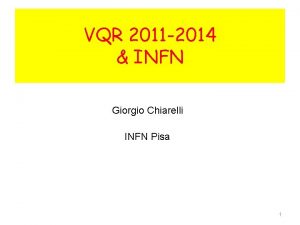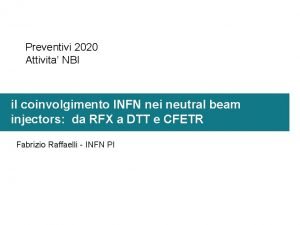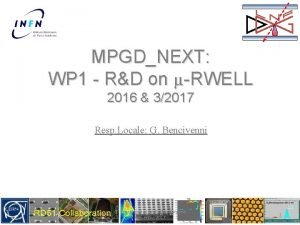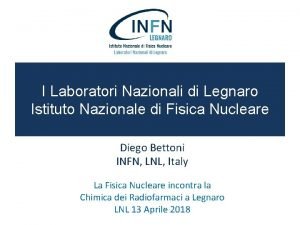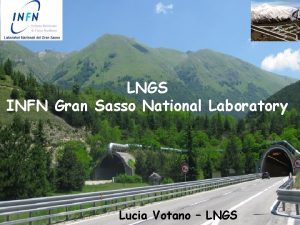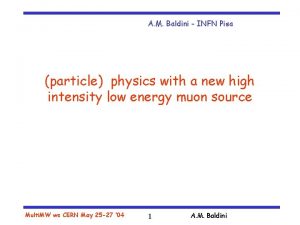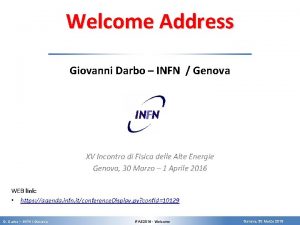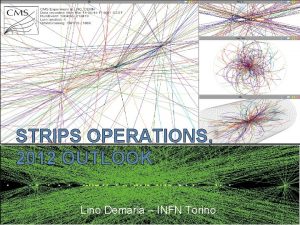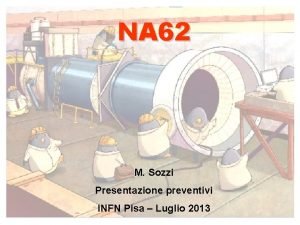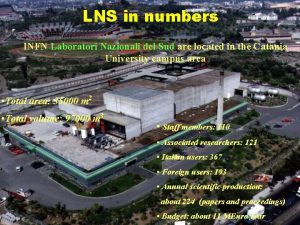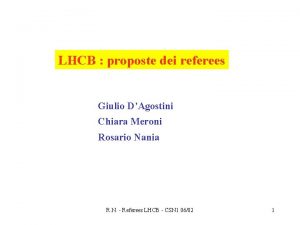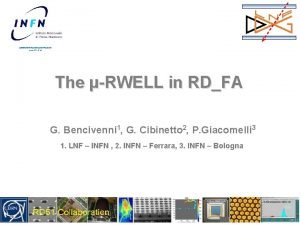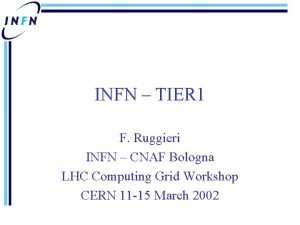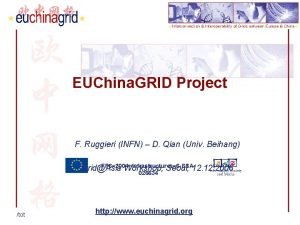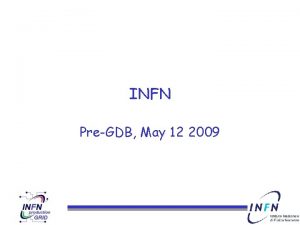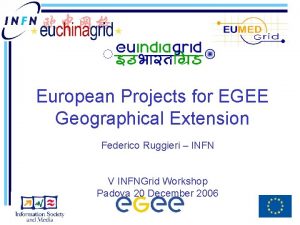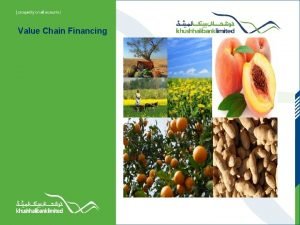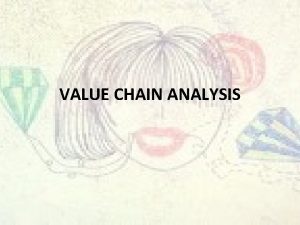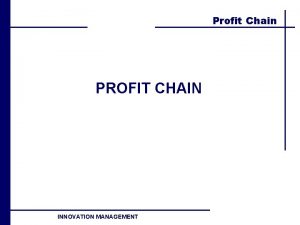CHAIN Project Federico Ruggieri INFN Federico Ruggieriroma 3



















- Slides: 19

CHAIN Project Federico Ruggieri – INFN (Federico. Ruggieri@roma 3. infn. it) Workshop on Regional Extensions of Grid Infrastructures EGEE’ 09 – Barcelona - 23 September 2009

Outline • Regional Grid Infrastructures co-funded by the European Commission • Commonalities and differences • A common strategy for the future • Conclusions

Globalisation of Grid Infrastructures CNGrid EUAsia. Grid Garuda

Why ? - To extend the ERA • e-Infrastructures support wide geographically distributed communities → enhance international collaboration of scientists → promote collaboration in other fields. • Grids and networks allow the access of many researchers to scientific resources (laboratories and data) → disparity can be reduced and larger participation and contributions to high quality research. • The e-Infrastructures promote the usage of network connectivity and stimulate scientific and technical development of countries → contribute to fight the digital divide and brain drain.

Who ? - Two (at least) scenarios • Greenfield regions/countries – No previous Grid and e-Infrastructures activities – Scarce knowledge and/or experience in deploying/managing large e-Infrastructures. – Isolated spots of research activities with high computing demands. • Advanced regions/countries – – e-Infrastructures already started/deployed Locally developed MW. Fair to good knowledge and experience in e-Infrastructures High quality research groups and institutions with world wide collaborations.

How ? - Consolidated Work-plan Seek, identify, and support e-Science communities and deploy their applications Set-up and manage a Pilot Grid Infrastructure Disseminate, both “bottom-up” and “top-down”, the e. Infrastructure paradigm for long term sustainability of e-Science Train users and site administrators to use and operate an e. Infrastructure based on the EGEE middleware

How ? - Instruments & methods • National Grid Initiatives – Internal (national) Infrastructures sustainability is still an issue. • Regional coordination – Difficult to shape the demand of collaboration with Europe in a Regional perspective (bilateral agreements always preferred). • Coordination and interoperation with EGEE (in future with EGI). • Stable Communication Networks co-operations still under development. – Synergistic approach with GEANT and EU NRENs and specific regional networks projects, i. e. ALICE, EUMEDCONNECT 2, TEIN 3, ORIENT

Training, training, …. Training ! Cooperation with EPIKH, a Marie Curie Action, that aims to: • Reinforce the impact of e-Infrastructures in scientific research defining and delivering stimulating programme of educational events, including Grid Schools and High Performance Computing courses; • Broaden the engagement in e-Science activities and collaborations both geographically and across disciplines. • Started in 2009 and will last for 48 months (www. epikh. eu)

Networks, networks, …. Networks !

Applications &Virtual Communities International, large impact, computing or data intensive • Particle Physics and Astrophysics • Earth and Environmental Sciences • Archaelogical applications (Archaeo. Grid) • Bio-Informatics and Biomedical applications. • Medicine • Humanities • ….

Dissemination, … dissemination ! • Key activity is to disseminate the opportunities and achievements that are possible with the use of e-Infrastructures • Contact scientific groups and institutions to involve them becoming users. • Publicise the successful use cases towards general public and stakeholders and politicians also by means of brochures, press releases, etc. e-Infrastructures across the Mediterranean

Workshops, conferences, policy • Technical workshops are key to attract new communities and consolidate the participation of the already involved scientists and technical people. • High policy events aim to awake the interest of stakeholders and politicians in order to make steps forward towards long term sustainability.

Specific topics • In Greenfield regions: – g. Lite and European approaches have been exported; – the Grid infrastructures have been promoted and are not yet sufficiently mature to be sustainable; – The same process in Africa is just starting. • In large, rapidly developing, countries: – they have already well defined Grid infrastructures (China, India); – different Middleware implementations (not only g. Lite and ARC); – Internal (national) sustainability should not be an issue. • Interoperability and interoperations with European Infrastructures and sustainability are the main goals – presently addressed in the activities of short lived projects (2 years max. ) with different speeds and time shifts due to the different EU calls where they have been approved; – coordination, alignment of results, common road-maps are difficult to achieve, although being strongly pursued by all the projects.

What’s next • A new step forward - International Virtual Research Communities highly need e-Infrastructures with coordinated management and support to create truly global communities that can seamlessly use several e-Infrastructures. • Value for EU - Europe has decisively contributed to the advent of e-Infrastructures in emerging regions (Africa, Asia, LA, Mediterranean) and new candidate EU countries (SEE, Baltic). Their evolution towards sustainable regional e-Science infrastructures should be finalised. • Objectives: – Enhance the collaboration / coordination and harmonisation of European and non-European e-Infrastructures in coherence with the EGI implementation. – Co-ordinate and support the dissemination towards politicians and stakeholders for long term sustainability of e-Infrastructures in the regions concerned. – Actively promote the adoption of standards and interoperable middleware solutions among the different regions.

CHAIN proposal • EU partners: those managing past and existing initiatives of Regional Grid Infrastructures covering Africa, Asia, Latin America and South East Europe. • A number of non-EU partners as representatives of their regions. The preferred choice is to have a consortium or a single Organisation representing the whole region. • Main activities 1. Assessment - Take stock and analyse the experience accumulated in the regional projects 2. Policy Development – coherent scheme of cooperation and interoperation of European and non-EU e-Infrastructures 3. Technical – export EGI supported solutions and promote interoperation with other non-EU e-Infrastructures. 4. Leverage on cross-region communities and applications, promote interregional, e-Infrastructures based, research infrastructures.

Provisional list of partners • • • INFN (Italy - Coordinator) CESNET (Czech Rep. ) CIEMAT (Spain) GRNET (Greece) IHEP (China) UBUNTUNET (Africa) CLARA (Latin America) KNK (India) CAMREN (Mediterranean) ……………

Timing 2009 2010 EGEE III 2011 EGI EELA II EUAsia. Grid SEEGRID-SCI Africa CHAIN EUMEDGRID-Support EUIndia. Grid 2 2012

Conclusions • It’s a long road … to build stable e-Infrastructures, even in Europe. An unreasonable acceleration can’t be applied to other regions. • On the other hand many of those regions need to accelerate in order to catch up the more developed countries. • However, some rapidly developing countries have already made it and are willing to interoperate with similar Infrastructures in other regions of the world. • World wide spread scientific communities have started to appreciate the opportunities of working together on large interregional e-Infrastructures. • It’s time to produce a coherent, multi-region and multi-path road -map for the sustainability and interoperations of those Regional infrastructures towards EGI and among themselves.

Thank you !
 Marina ruggieri
Marina ruggieri Davide ruggieri unibo
Davide ruggieri unibo Marco ruggieri
Marco ruggieri Davide ruggieri
Davide ruggieri Eltonian pyramid
Eltonian pyramid Difference between logistics and supply chain
Difference between logistics and supply chain Open kinetic chain
Open kinetic chain Giorgio chiarelli infn
Giorgio chiarelli infn Infn preventivi
Infn preventivi Www.lnf.infn.it
Www.lnf.infn.it Rilab data sc
Rilab data sc Infn gran sasso
Infn gran sasso Diego bettoni
Diego bettoni Infn pisa
Infn pisa Infn genova
Infn genova Infn webmail torino
Infn webmail torino Preventivi infn
Preventivi infn Lns infn
Lns infn Chiara meroni infn
Chiara meroni infn Www.lnf.infn.it
Www.lnf.infn.it
